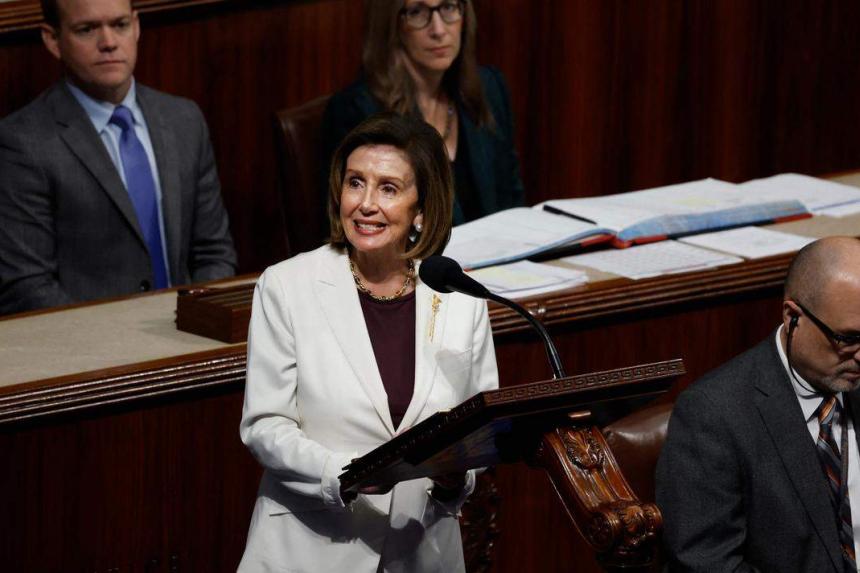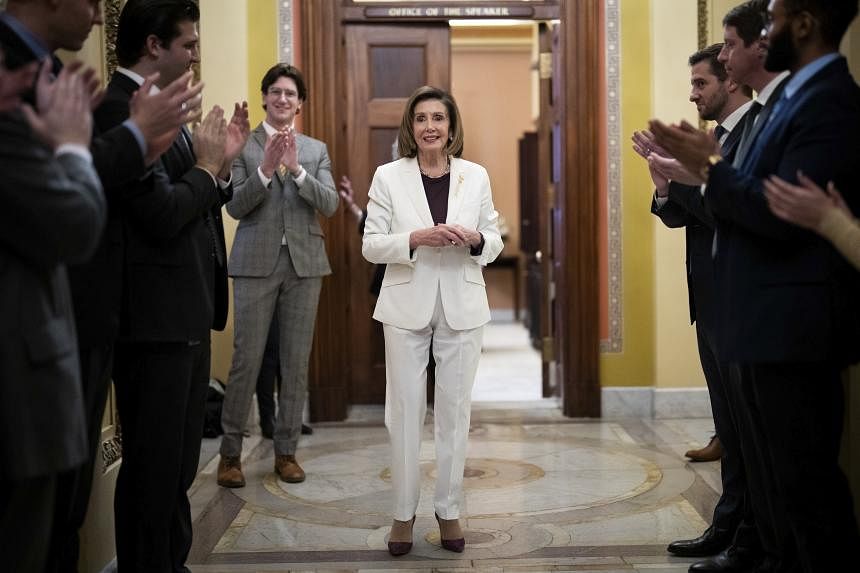WASHINGTON – Back in 2019, Ms Nancy Pelosi left a particularly contentious White House meeting with then President Donald Trump over the prolonged government shutdown and offered a concise description of how the negotiations went.
“I’m a mother of five, grandmother of nine. I know a temper tantrum when I see one,” Ms Pelosi said of the president, describing how he stormed out of the meeting.
Ms Pelosi, 82, has never shied away from subjects like child-rearing, even as she climbed a notoriously male-dominated congressional power structure. And so on Thursday, when Ms Pelosi announced she wouldn’t run again for Democratic leader, she wore suffragist white and highlighted the very first item on her resume.
“Never would I have thought that some day I would go from homemaker to House speaker,” she said to a standing ovation on the House floor.
Ms Pelosi paved the way for a generation of female legislators, many of whom now hold positions of power.
When she joined the House in 1987, there were 12 Democratic women. “Now there are 90, and we want more,” she said on Thursday.
Representative Annie Kuster, a New Hampshire Democrat, said Ms Pelosi changed the dynamic around being a working mother. When she was a young lawyer, Ms Kuster said she had to hide that she had children. That made Ms Pelosi’s oft-repeated motto “For the Children” an empowering one.
“She’s expanded the image of who can lead. She’s disrupted the image of who can lead and opened the door for all kinds of folks to walk through it and to be in these positions,” added Ms Debbie Walsh, director of the Center for American Women and Politics at Rutgers University.
Be on her good side
Ms Pelosi’s leadership hasn’t been without friction, both within her own party and with other female lawmakers. Clashes between her and the original “Squad”, a group of congresswomen elected in 2018 that includes Representative Alexandria Ocasio-Cortez, regularly made headlines. Others acknowledged there could be tense moments.
“I’ve been on the good side of Nancy Pelosi and the bad side, and it’s much more pleasant to be on the good side,” said Representative Debbie Dingell, a Michigan Democrat.
In the end, Ms Walsh notes, Ms Pelosi has been able to keep the divergent wings of the caucus together on many key votes.
Ms Pelosi used her gender as a tool, often remarking that she gave birth to five children in six years as a reminder of the full extent of her capabilities.
“We’ve seen her use toddler management skills from time to time,” said Pennsylvania Democratic Representative Mary Gay Scanlon, a mom of three. “You don’t let someone get away with anything, because then they’ll do it again.”
Before Ms Pelosi first took the speaker’s gavel in 2007, women had served as Supreme Court justices and in top Cabinet roles – but none had commanded their party.
In an interview with Bloomberg News just days before the 2006 elections – where Democrats won House control, clearing her path to the speakership – she said her ascension would show that women “can breathe in that rarefied atmosphere” at the highest pinnacles of power.
Her rise helped set the stage for other women to push higher in politics, including Mrs Hillary Clinton, whose 2016 Democratic presidential nomination made her the first woman to lead the ticket for a major party, and Ms Kamala Harris, the nation’s first female vice president.
Ruffling feathers
The daughter of Mr Thomas D’Alesandro, a former Baltimore mayor and congressman, Ms Pelosi moved to San Francisco after college and her marriage to Mr Paul Pelosi, an investment banker. She volunteered for her party, early on attracting notice as a prolific fundraiser and eventually becoming chairwoman of the California Democratic Party.
She didn’t run for a House seat until she was 47 and the youngest of her five children was in high school.
By 2001, she won the race for Democratic whip, the No. 2 job. When Mr Dick Gephardt stepped down in 2002, Ms Pelosi quickly locked up the votes to replace him as minority leader.
She has worked to put her own touches on some of the House’s traditions, often to the frustration of her male colleagues.

Just days after first rising to the speakership, she banned smoking in the ornate Speaker’s lobby just off the House floor, ending a privilege cherished by then-Republican leader John Boehner and others. In 2011, she created a women’s bathroom just off the floor, a long-overdue addition applauded by her female colleagues and staff.
Ms Pelosi embarked on a “Greening the Capitol” plan to make the House campus more socially progressive and environmentally sound, including revamped House cafeteria menus that replaced fatty processed foods with healthier gourmet choices.
Mostly, though, she has shown she can be a tough leader in the House, at times threatening Democrats who defied her with the loss of top committee assignments or forcing them to sit through all-night negotiating sessions in her office to twist arms on tough votes.
‘San Francisco liberal’ with an iron fist
In one of her first acts as speaker, she created six-year term limits for panel chairs – surprising a cluster of senior chairmen called “Old Bulls” who thought they could rival her influence.
Republicans found a speaker they dismissed as a “San Francisco liberal” who could rule with an iron fist, allowing them few chances to alter Bills. She also was a fierce counterweight to the policies of former presidents George W. Bush and Mr Trump.
Democratic unity against Mr Bush’s proposal to create private Social Security accounts helped force Mr Bush to eventually drop the idea and was seen as setting the stage for Democrats to take the House and Senate in 2007. And party lockstep against Mr Trump’s Obamacare repeal drive helped to implode it and provide a narrative to the Democratic House takeover in 2018.
Her clashes with Mr Trump were particularly acute. She called his 35-day government shutdown in 2018 and 2019 a “hostage-taking” of civil servants and refused to let him use the House chamber to give his State of the Union address while it was going on. A year later, when he delivered his next address, she tore up her copy of it as TV watchers looked on, later calling it “such a dirty speech”.
She advised Mr Obama against abandoning his sweeping health care push in favour of smaller initiatives that could more easily get enacted, calling the slimmed-down proposal “kiddie care”. She successfully rallied Mr Obama and Democrats behind a broader Bill that cleared just two months later.
Fashion statement
Ms Pelosi’s tenure coincided with a broader understanding of fashion as a political tool. Her pantsuits – ranging in hues from regal purple at her first speaker swearing-in to suffragist white at Mr Trump’s 2020 State of the Union address – regularly made headlines.
No stranger to being the only woman in a room, Ms Pelosi showed women they should stand out in a sea of dark suit-clad men and, more importantly, project power not in spite of being a woman but because they are women.
Representative Madeleine Dean, a Pennsylvanian Democrat, brought her granddaughter to the House floor when she was sworn in so she could see a woman leading the chamber.
“We shouldn’t say ‘Can a woman do it?’ anymore,” Ms Dean said. “Talk about glass ceilings, she breaks them every time.” BLOOMBERG

